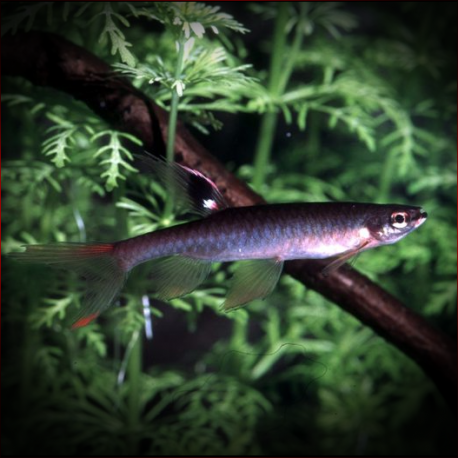More info
Datasheet
| Minimum Tank Size | 90 litres / 23.78 US gallons |
| Maximum Size | 4.0cm / 1.57inches |
| Temperature | 20°C / 68.00°F - 28°C / 82.40°F |
| Hardness | 1.01dgH / 18ppm - 10.03dgH / 179ppm |
| pH | 4.0-7.0 |
General Description
The species Copella carsevennensis, belonging to the family Lebiasinidae within the Characiformes order, is a diminutive fish with males growing significantly larger, boasting more-extended fins, and displaying intense colors compared to the rounder-bodied females. This fish is distinguishable by specific characteristics such as scale count, absence of certain markings, and preferred placement of eggs.
Aquarium Setup
For an optimal tank setup for Copella carsevennensis, a densely-planted environment with overhanging vegetation, roots, or branches is recommended. It is advised to include floating plants as the species tends to prefer dimmer lighting and occupies the upper water layers. The addition of dried leaf litter and alder cones is beneficial for creating a natural feel, providing cover, and promoting microbe colonies. Well-oxygenated water with slight surface agitation is necessary, and stability in water chemistry is crucial.
Behaviour
Although generally peaceful, Copella carsevennensis may not be ideal for a regular community tank. It thrives when housed with similar-sized companions such as characids, gasteropelecids, lebiasinids, small callichthyid or loricariid catfish, and non-predatory cichlids. Maintaining a mixed-sex group of at least 8-10 individuals, accompanied by schooling fish for security, results in a visually appealing aquarium. Male specimens exhibit vibrant colors and engaging behaviors while vying for female attention.
Feeding and Diet
In the wild, Copella carsevennensis likely feeds on small invertebrates and zooplankton. In captivity, they accept appropriately-sized dried foods but necessitate daily meals of small live or frozen fare like Artemia nauplii, Moina, or grindal worms. Providing small insects such as crickets or fruit flies can also be suitable, after ensuring they are adequately fed with fish flakes or vegetable matter.
Reproduction & Dimorphism
Reproduction in Copella carsevennensis involves egg deposition among vegetation, with males guarding and tending to the brood. Fry may appear without intervention but controlled breeding in a separate tank is advisable for maximum yield. Nuptial males establish territories and attract females for spawning, after which the male cares for the eggs until hatching. Sexual dimorphism is notable, with males being larger, possessing extended fins, and displaying more vivid colors compared to the rounder-bodied females.
Habitat and Distribution
The species is distributed across coastal river systems in Guyana, Suriname, French Guiana, and Amapa state in northeastern Brazil. The type locality is attributed to the "Carsevenne" river drainage in Amapa, though initial reports cited "French Guiana." Copella carsevennensis thrives in these habitats and adapts well to similar conditions in captivity.
NOTE: Do not forget to refer to the table for specific water condition requirements for Copella carsevennensis.

